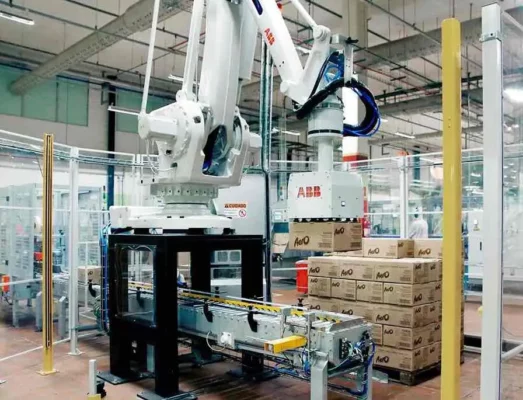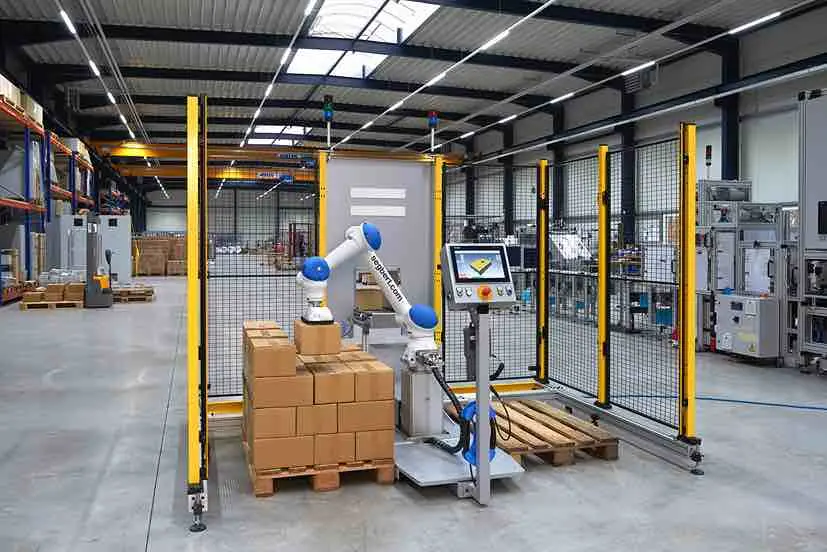Choosing the right palletizing robot can boost your efficiency and save you money. You might be asking, “What will a palletizing robot cost me?” Knowing the costs is key to making a smart decision.
This article will help you understand everything from the initial purchase to installation, integration, and maintenance. By breaking down these costs, you’ll be better prepared to budget and get the best return on your investment.
Let’s explore the details so you can find the perfect palletizing robot for your needs.
What is a Palletizing Robot?
A palletizing robot helps you automate stacking and arranging products on pallets. It’s designed to boost efficiency and cut down labor costs in your manufacturing line. There are different types like articulated, SCARA, and gantry, each fit for specific tasks and settings. These robots have sensors and software to handle various products, whether they are boxes, bags, or other items.
You can program your palletizing robot to work non-stop, ensuring accurate and consistent stacking. This speeds up the process and reduces the risk of worker injuries. By adding a palletizing robot to your production line, you can improve workflow, save on labor costs, and maintain high standards. Investing in a palletizing robot helps you modernize your operations and stay competitive in the industry.
The video shows an ABB robotic arm palletizing cartons, efficiently stacking boxes onto a pallet in an automated process.
How Does a Palletizing Robot Work?
Picking Items:
The robot grabs items from a conveyor or platform using programmed movements and sensors.
Holding with Grippers:
It uses specially designed grippers to securely hold your boxes, bags, or cartons.
Stacking Patterns:
You can program it to stack items in specific patterns to ensure stability and save space.
Precise Placement:
It places your items on a pallet with accuracy, reducing mistakes and boosting efficiency in your operation.
The video shows a robotic palletizing system stacking various packages onto pallets in a manufacturing facility, demonstrating its automated and precise handling process.
5 Factors Influencing the Cost of a Palletizing Robot:
1. Type of Robot:
The type of robot you choose affects the price. You have options like articulated robots, SCARA, gantry robots, and collaborative robots (cobots). Cobots, which work safely alongside humans, may cost more due to their advanced safety features.
2. Payload Capacity:
The robot’s payload capacity impacts its cost. Robots that can handle heavier items are usually more expensive. Consider the weight of the items you need to palletize.
3. Reach & Speed:
Reach and speed are also key factors. Robots with longer reach and faster speeds typically come at a higher price. Think about your specific needs to choose the right robot.
4. Brand & Manufacturer:
Different brands have different prices. Top brands like ABB, FANUC, Universal Robots, and KUKA might be pricier due to their reputation and reliability. Compare brands to find one that fits your budget.
5. End-Effectors & Tooling:
End-effectors and tooling add to the cost. Grippers and other tools needed for your application can increase the overall expense. Make sure to include these in your budget.
By considering these factors, you can find a palletizing robot that meets your needs and fits your budget.

Breakdown of Costs:
Initial Purchase Price:
The cost of a palletizing robot varies based on type and specs.
- Entry-level models: $25,000 to $50,000. Good for simpler tasks and lighter loads.
- Mid-range models: $50,000 to $100,000. Offer more features and handle moderate loads.
- High-end models: $100,000 and above. Designed for complex tasks and heavy loads.
Installation Costs:
Setting up your palletizing robot will add to your costs. On average, installation costs range from $5,000 to $20,000. This includes mounting, calibrating, and ensuring the robot works correctly in your production line.
Integration with Existing Systems:
You’ll need to integrate the robot with your current software and hardware. This can cost between $10,000 and $50,000, depending on how complex your systems are and how compatible they are with the new robot.
Training & Support:
Training your operators and providing ongoing support are essential. Training costs about $1,000 to $5,000 per operator. Ongoing support, including software updates and maintenance, can cost you an additional $2,000 to $10,000 annually.

Hidden Costs & Additional Expenses:
Maintenance & Repairs:
Regular maintenance is crucial to keep your palletizing robot running smoothly. You should budget around $1,000 to $5,000 each year for maintenance. Repair costs can vary, so be prepared for unexpected expenses.
Spare Parts:
You’ll need to replace parts like grippers and sensors over time. Plan to spend about $500 to $2,000 per year on these replacement parts and consumables.
Software Updates:
Keeping your robot’s software up-to-date is essential. Expect to pay $500 to $3,000 annually for software updates and licensing fees. These updates ensure your robot stays compatible with your systems and has the latest features.
Energy Consumption:
Running your palletizing robot will increase your power usage. Depending on its size and workload, you might see an extra $1,000 to $3,000 per year in energy costs. Keeping an eye on your energy use can help you manage these expenses.
Cost-Saving Strategies:
Leasing vs. Buying:
Leasing a palletizing robot can save you money upfront. You pay a monthly fee instead of a large initial cost. Leasing also lets you upgrade to newer models easily. However, leasing can be more expensive in the long run. Think about your long-term needs before deciding.
Used & Refurbished Robots:
Buying used or refurbished robots can cut costs. These robots are often much cheaper than new ones. Make sure you buy from a reliable source to avoid problems. While you save money upfront, you might face higher maintenance costs and shorter robot lifespans.
Government Incentives & Grants:
Check for government incentives and grants for automation. Many governments offer financial aid and tax breaks for businesses investing in automation. These incentives can lower your costs significantly. Look into local programs and apply for any you qualify for to maximize your savings.
ROI & Long-Term Financial Benefits:
Increased Efficiency & Productivity:
Palletizing robots can make your work faster and more efficient. They work all the time without needing breaks, speeding up the palletizing process. This boosts your output and reduces downtime, saving you money over time.
Reduction in Labor Costs:
Using palletizing robots means you need fewer manual workers. This saves you money on wages, benefits, and other employee costs. Robots do the repetitive tasks, freeing your human workers to do more important jobs.
Enhanced Accuracy & Consistency:
Palletizing robots are very precise and consistent. They handle tasks accurately, reducing product damage and waste. This means higher quality results with fewer mistakes, leading to big savings in the long run.
For an easy way to calculate your ROI and plan your robotic project, use Alina.
Conclusion:
Investing in a palletizing robot can change your manufacturing line. You will work faster, spend less on labor, and improve accuracy. The initial and ongoing costs might seem high, but the long-term benefits and quick ROI make it worth it. By understanding what affects costs and looking for ways to save money, you can make a smart choice. Use tools like Alina to help with financial planning and ROI calculations. With careful planning, a palletizing robot can boost productivity and save you money in the long run.
